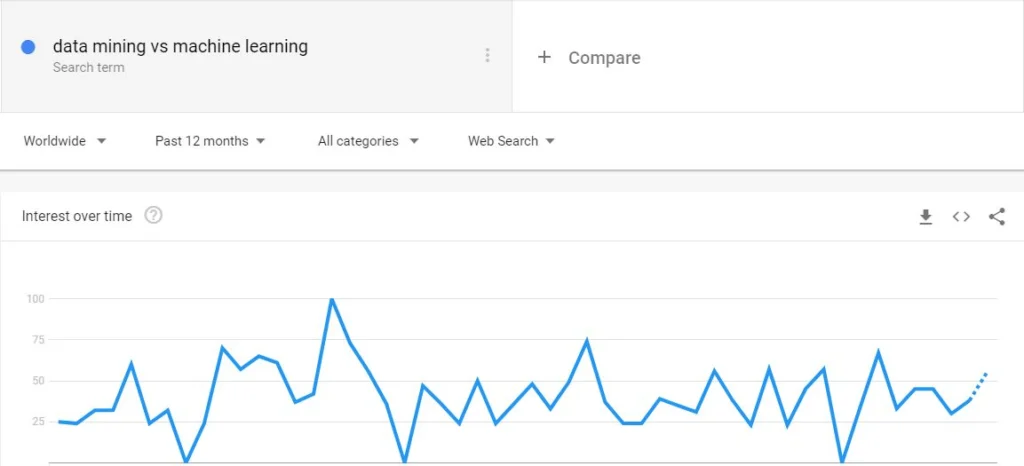Recent technological developments have enabled the automated extraction of hidden predictive information from databases. To drive greater value from data, companies across the globe are taking more interested in learning about technologies such as Statistics, Machine Learning, Artificial Intelligence, Data Mining, and pattern recognition. Most of our Machine Learning as a service clients shows a great deal of interest in learning about Data Mining vs Machine Learning.
Data Mining enables the extraction of information from a large pool of data. This technique is employed to discover different patterns inherited in a given set of data to generate new, precise and useful data. Data Mining is similar to experimental studies and works as an extension to business analytics.
Machine Learning on the other hand, includes algorithms that can automatically improve through data-based experience. With experience, it finds new algorithms and enables the study of an algorithm that can automatically extract the data. Machine Learning solutions employ Data Mining techniques and other learning algorithms to construct models of how information is being generated to predict future results.
Data Mining and Machine Learning are often combined, have overlapping properties and influenced by each other in some ways, however individually they have different ends.
Machine Learning vs Data Mining Trend in 2020

Just in the last month, 160 people searched for Data Mining Vs Machine Learning. Most of the searches for Data Mining vs Machine Learning were from India. South and West US seem to be taking a lot of interest in these technologies as well. Overall, people have been consistently looking for information relating to these technologies and given the upward, it is likely that it will get more traction in the coming days.
Source: Google Trends
Data Mining vs Machine Learning – Core Comparison Overview
| Basic Comparison | Data Mining | Machine Learning |
| Meaning | Knowledge extraction from a large pool of data | Introduce new algorithms from data, based on experience |
| History | Introduced in 1930 as knowledge discovery in databases | Introduced in 1950 through Samuel’s checker-playing program |
| Responsibility | Data Mining extracts the rules from the existing data | Machine Learning facilitates computers to learn and understand the given rules |
| Origin | Traditional databases with unstructured data | Existing data as well as algorithms |
| Implementation | Data Mining techniques can be employed on different models | Machine Learning algorithm can be utilized in the decision tree, computer vision, neural networks and some areas of AI |
| Nature | Requires manual human interference | Designed as an automated process |
| Application | Used in cluster analysis | Used in web search, spam filter, credit scoring, fraud detection, cognitive services and computer design |
| Abstraction | Data Mining abstract from the data warehouse | Machine Learning reads machines |
| Techniques involve | Data Mining takes a research-based approach | Self-learned and trains system to do the intelligent task |
| Scope | Limited area application | Can be used in a vast area |
| Algorithm | Data Mining employs many algorithms such as a statistically based method, Machine Learning based method, classification algorithms, neural network and many others. | Machine Learning also utilizes many algorithms such as supervised Machine Learning algorithms, unsupervised Machine Learning algorithms, semi-supervised learning algorithm, clustering algorithms, regression, Bayesian algorithm and many more. |
| Pattern Recognition | Data Mining uncovers hidden patterns by using classification and sequence analysis. | Machine Learning, uses the same concept but in a different way. Check out these predictive analytics solutions |
| Open Source Tools | For Data Mining, open source tools are Rapid Miner; KNIME and Rattle are used. | Machine Learning open source tools are Shogun, Theano, Keras, Microsoft Cognitive Toolkit (CNTK), |
| Technology | Some of the most sought-after software for Data Mining on the market are: Sisense, Oracle, Microsoft SharePoint, Dundas BI and WEKA. | Poplar software for developing Machine Learning models are: Google Cloud ML Engine, Amazon Machine Learning and Apache Singa. |
| Industries | Data Mining projects are those where numerous data is available such as medical science, banking and research. | Machine Learning can be used in identifying product bundles, sentiment analysis of social media, music recommendation system, sales prediction, and many more. |
Is Data Mining Better than Machine Learning?
Data Mining and Machine Learning share a foundation in data science and there is an overlap between the two. Data Mining can utilize Machine Learning algorithms to improve the accuracy and depth of analysis. While Machine Learning can employ mined data as its foundation, in order to refine the dataset to achieve better results. It can be argued that Data Mining and Machine Learning are similar when it comes to extracting meaningful information from a given set of data. However, the differences lie in the way in which they achieve this end and their applications.
The most obvious difference is their approach to data analysis. Data Mining allows analysts to combine and study vast amounts of structured or unstructured data, without driving any processes by itself. Machine Learning, on the other hand, has capabilities to learn from new data and become more intelligent with experience, without being programmed.
For instance, Data Mining is utilized by e-commerce retailers to identify which products are frequently bought together, enabling them to make recommendations accordingly. Machine Learning, on the other hand, has powers to go deeper and learn from customers’ buying habits to improve its ability to recommend products; whereby becoming better over time.
Another important difference between Data Mining and Machine Learning is the purpose they fulfill. Where, Data Mining is widely used in retail to identify sales trends and customer purchase patterns, to allow companies create better marketing campaigns and forecast sales; it is also used for identifying investment opportunities, detecting fraud and financial planning. While Machine Learning offers more accurate insights, often in real time, It facilitates revolutionizing sales and marketing by enabling customized shopping experiences based on purchase history.
Data Mining and Machine Learning have differences in their applications to enterprise too. Data Mining can be integrated with any given ERP application and can work with diverse processes. To this end, a Machine Learning project would require considerable resources. From assembling the training and test data to feature extraction and selection, project managers need to have everything in place. Moreover, with Data Mining activities can kick-off with a quick sign-off, while Machine Learning projects go through complex forms of buy-in from various stakeholders.
Machine Learning can be one of the steps of a Data Mining, if you are interested in developing algorithms. So if you are interested in developing algorithms that create models then you will pick Machine Learning but if your aim is to investigate data and create models by using existing algorithms, then Data Mining will have to be employed.
When it comes to understanding Machine Learning vs artificial intelligence vs Data Mining, in simplest terms Artificial Intelligence is the study to create intelligent machines that can come up with solutions to problems based on their learning. Data mining forms part of the programming codes with the necessary information and data AI systems. A large part of Artificial Intelligence falls under Machine Learning. AI uses Machine Learning algorithms for intelligent behavior.
The data universe is growing at a rapid scale; creating greater demand for advanced Data Mining and Machine Learning techniques in order for the industry to keep evolving. There is likely to be more overlap between the two techniques as the two intersect to improve the usability and predictive capabilities of large amounts of data for analytics purposes.
While Data Mining is drawing unparalleled capabilities for predictive analysis, only the surface of Machine Learning has been scratched. With billions of machines becoming connected and human’s generating vast amounts of data on a daily basis, we should not be looking at Machine Learning vs Data Mining or Machine Learning vs artificial intelligence vs Data Mining but at how these technologies can be used to add further value to businesses.
Data Mining vs Machine Learning FAQs
What is meant by Machine Learning in Data Mining?
Data Mining is a cross-disciplinary field that focuses on finding properties of data sets. Whereas, Machine Learning is a subfield of data science that focuses on designing algorithms that can make predictions and learn from the data. Machine Learning in Data Mining is when results of Machine Learning are used in Data Mining. Data Mining can employ other techniques besides or on top of Machine Learning.
What’s the core difference between Big Data and Machine Learning?
Big data analytics involves the analysis of big data to discover hidden patterns and extracting information. Whereas, Machine Learning, is a technique that employs Machine Learning models to respond to unknown inputs and give desirable outputs. Even though both big data and Machine Learning can be used to find specific types of data & parameters, Big data can not identify relationships between existing pieces of data with the same depth as Machine Learning. While Machine Learning is a part of Data Science, Big data has got more to do with High-Performance Computing.
It is often the case that Big data analytics is used to analyze and transform data to extract information, which then goes through a Machine Learning system for further analysis to predict output results.
Machine Learning performs tasks without the need for human interaction. Whereas, Big data analysis gives structure and models the data for humans to make more informed decisions.
What’s the Core Difference Between Data Mining vs Statistics?
Both Data Mining and Statistics are tools that extract information from data by discovering and identifying structures. Statistics are similar to Data Mining, as they both are used for data-analysis to facilitate decision-making. However, individually they are very different techniques that require different skills. Statistics employs tools to find relevant properties of data, whereas Data Mining builds models to detect patterns and relationships in a given set of data.
Data Mining requires the application of various methods of statistics, data analysis and Machine Learning to study and analyze large data sets in order to drive meaningful information and make accurate predictions. Whereas, Statistics is at the core of Data Mining, whereby utilizing identification models designed for inference about the relationships between variables that can further be analyzed to identify differences between random noise and significant findings — such as theories for establishing probabilities of predictions.
Is Machine Learning better than Statistics at all?
Machine Learning algorithms are designed to work with large datasets whereas statistical models work well with smaller sets of data with clear features. Machine Learning beats statistics, when it comes to large datasets, especially when the data lacks describable features. Statistics on the other hand may prove better than Machine Learning when there is a need to identify relationships between data points to gain better insight into a given problem domain.
Start Gowing with Folio3 AI Today
We are the Pioneers in the Cognitive Arena – Do you want to become a pioneer yourself?
Please feel free to reach out to us, if you have any questions. In case you need any help with development, installation, integration, up-gradation and customization of your Business Solutions. We have expertise in Deep learning, Computer Vision, Predictive learning, CNN, HOG and NLP.
Connect with us for more information at Contact@folio3.ai









